Book contents
- Frontmatter
- Contents
- Preface
- Acknowledgements
- Chapter 1 Plants and the origin of the biosphere
- Chapter 2 Description of vegetation: the search for global patterns
- Chapter 3 Resources
- Chapter 4 Stress
- Chapter 5 Competition
- Chapter 6 Disturbance
- Chapter 7 Herbivory
- Chapter 8 Positive interactions: mutualism, commensalism, and symbiosis
- Chapter 9 Time
- Chapter 10 Gradients and plant communities: description at local scales
- Chapter 11 Diversity
- Chapter 12 Conservation and management
- Questions for Review
- References
- Index
- References
Chapter 12 - Conservation and management
- Frontmatter
- Contents
- Preface
- Acknowledgements
- Chapter 1 Plants and the origin of the biosphere
- Chapter 2 Description of vegetation: the search for global patterns
- Chapter 3 Resources
- Chapter 4 Stress
- Chapter 5 Competition
- Chapter 6 Disturbance
- Chapter 7 Herbivory
- Chapter 8 Positive interactions: mutualism, commensalism, and symbiosis
- Chapter 9 Time
- Chapter 10 Gradients and plant communities: description at local scales
- Chapter 11 Diversity
- Chapter 12 Conservation and management
- Questions for Review
- References
- Index
- References
Summary
Some historical context. Ancient Assyria and Rome. Deforestation of the Mediterranean region. More vegetation types at risk. Louisiana wetlands. Oceanic islands: Easter Island and the Galapagos. Boreal forests. Protection of representative vegetation types. Principles for the design of reserve systems. Hot spots. Primary forests. Large wetlands. The Guyana highlands. Value of wilderness. Fragmentation: fens and deciduous forests. Functions and management. Two perspectives on conservation. Change through geological time. Ecological footprints. Thresholds. Restoration. Indicators. Monitoring. The thin red line. Where does one go from here?
Introduction
It is time to put the picture together. We began the book by exploring how plants have evolved and how plant communities have formed in response to fundamental factors such as resources, stress, disturbance, and herbivory. We have also encountered selected examples of how humans interfere with these ecological processes that create and maintain plant communities, such as overgrazing arid grasslands (Section 4.3.2), introducing exotic species that feed on wetland plants (Section 7.4.6), logging boreal forests (Section 9.4.3), or fertilizing infertile plant communities (Section 11.6.2). There are nearly 300,000 plant species in the world, but as human populations increase, and as we disrupt the natural forces that create plant communities, the destruction of plants and vegetation will accelerate. This is not an exaggeration. In some parts of the world, more than 90 percent of the natural primary vegetation has already been cleared. The list includes: southern central China, Sri Lanka, Burma, Madagascar, West Africa and southeastern Brazil (the Atlantic Forest) (Myers et al. 2000).
- Type
- Chapter
- Information
- Plants and VegetationOrigins, Processes, Consequences, pp. 549 - 609Publisher: Cambridge University PressPrint publication year: 2007



